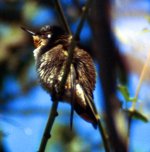My understanding is that it is a mechanism designed by nature to allow these birds to withstand periods of inclimant weather. People have described finding a bird and thinking it was dead - even to the point of boxing it up and preparing for a burial - only to have the bird "revive" and be successfully released. I recall one account where the person found the bird dormant on the feeder, touched it and the bird fell to the floor, picked it up, put it in a box and left the box on the kitchen table for a minute. When they looked over, the lid of the box was bouncing and their "dead" hummingbird was very much alive.
From what I understand, all metabolic processes are significantly lowered - pulse, respiration and of course, digestion. This allows the animal to survive with little or no energy intake. It is one area, among many, in these fascinating animals that I want to know more about!
Mark




